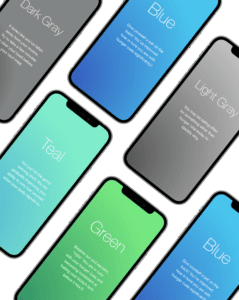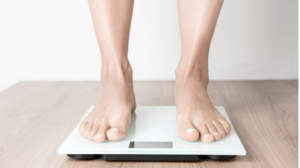How To Track Weight Loss Without a Scale
As practical as they are, scales can sometimes be misleading as you build muscle, which affects how you perceive the success of your weight loss journey. Weighing yourself every day on a scale can be tricky since the scale is not accurate and does not account for changes such as undigested food or what time of the day it is.
Stepping on the scale first thing in the morning sets the mood for the day’s rest if you’re pleased with the number on the scale – excellent! If not, it can leave you feeling discouraged and defeated. This feeling of disappointment can lead to a lack of motivation and confidence. It can also get you into unhealthy habits of infatuation with seeing a number on the scale. This can make it easy for us to forget the many other factors that go into creating and maintaining a healthy weight. Harmful methods of weight loss may form such as restricting foods, overexercising, or prematurely punishing ourselves from this obsession with seeing the number on the scale decrease.
Luckily there are many practical alternatives to tracking and monitoring your weight loss where a scale is unnecessary! Whether you don’t own a scale and don’t plan on purchasing one or want to step away from the misleading number on the scale, here are 3 ways you can track your weight without needing one.
Measuring Tape
Old but gold, a measuring tape can always get the job done. A measuring tape is a useful tool that almost everyone has just lying around the house. When measuring yourself, you must do it correctly. Here are a few tips to ensure you’re measuring yourself the right way:
Take Measurements Every 4-6 Weeks
It’s important to remember that your measurements won’t change day to day. That’s why it’s excellent to take measures every 4-6 weeks to see the progress you’re making,
Measure the Same Spot
When measuring, make sure you’re always measuring the same area each time. The waist is a good indicator of how much fat has been lost, which is why the belly button is a great reference point!
Record & Repeat
Hold the tape parallel to the floor and wrap it around your waist. Hold the beginning of the tape at your belly button. Always remember to record the number that lines up with the start after it’s fully wrapped around the waist. Repeat every 4-6 weeks!
Other places to measure to track weight loss and/or muscle gain are the calves, neck, biceps, triceps, and thighs.
Body Fat Calipers
Body fat calipers are one of the most accurate ways to track weight loss without a scale. These calipers are used to administer what’s commonly known as the “pinch test” to measure body fat percentage. The body fat calipers estimate the thickness of subcutaneous fat (fat located underneath the skin on particular parts of the body)
*Note: if you are having a hard time finding body fat calipers, try looking for them under an alternative name, skinfold calipers.
Measurements are taken at 3, 7, or 10 points that vary between genders. For men, measurements are typically taken from:
- The chest
- The abdomen
- The thigh
- Triceps
- Shoulder blades
For women, measurements are typically taken from:
- The triceps
- The chest
- The abdomen
- The thigh
- The subscapular
After measurements are taken they’re entered into a formula to calculate body fat percentage.
How To Use Body Fat Calipers
- The right side of the body is commonly used for measurements with a body fat caliper. To start, use your left hand to pinch and fold the skin at the point you are starting at. Make a “C” shape using your thumb and index fingers to securely hold the pinched skin
- Now grab a caliper with your right hand. Hold it perpendicular to the pinched skin and place the jaw around the skinfold. At this point, you should still be holding the skin with your left hand.
- Using your right thumb, press where indicated on the caliper to lock it in place. Remove the caliper from the skinfold and record the measurement. Do this a total of 3 times in the same spot and use the average in the formula to calculate the body fat percentage.
- Repeat this process for each point you wish to test.
Every time you measure a point on your body, it’s important you pinch the same thickness of skin each time. Because of the accuracy needed, it’s common to find a personal trainer or doctor to take measurements for you. Measurements are typically taken once a month.
Using Old Clothes and Before & After Photos
Have a pair of jeans in your dresser that you’re determined to squeeze back into someday? Now is the time to whip them out and use them as a way to track your weight loss progress! If you’ve been working hard towards reaching your goal, trying on clothes that once didn’t fit you to see how they fit on your body now, is an eye-opener for the progress you’ve made and the potential you have. You may even be surprised with yourself regarding the amount of progress you’ve made!
Similarly, taking before and after photos in these once ill-fitting clothes is a great way to track your weight loss in a way you can visualize. Many fitness professionals visually document their journey with progress pictures. Not only can you see changes in your body, but it also gives you a chance to celebrate your success.
Seeing your body change right in front of your eyes will keep you motivated and accountable. If you’re really feeling brave or just feeling yourself a little extra because of your progress, post your pictures on Facebook! Sharing your progression with others is another great way to hold yourself accountable. This also gives you the chance to be flooded with support, as well as potentially inspire others in your life to start on their weight loss journey!
For before and after photos to be effective, make sure to take the photos in the same place and wear the same clothes. Keep in mind the more skin you show in the photos, the better you will be able to see the results. This is why many people pose in swimsuits for their before and after photos. If you do not have someone to help you take the photo for you, propping up your phone camera and using the timer setting will work just as well.
Regardless of the method you choose, the key is to keep a healthy mindset. If you know seeing a number constantly changing throughout your journey will affect how you feel mentally, sounds like before and after photos are a great choice! If you enjoy seeing your measurements decrease and are okay with the possibility of not seeing an “ideal” number – try the good old measuring tape!




